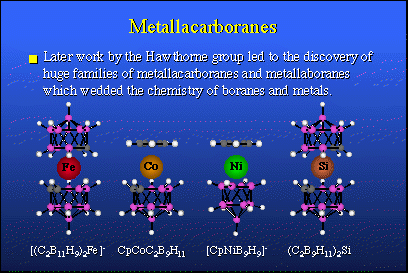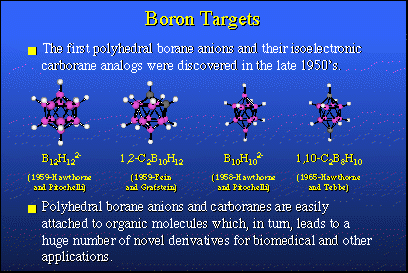|
|
Email: mfh@chem.ucla.edu |
The neutrons required for therapy are not too difficult to obtain. What is a bit difficult to get your hands upon are the proper chemicals, proper boron-10 containing agents which serve as neutron target species. Fortunately, in the past we did have a tremendous effort in the borane fuels, with rockets and airplanes, and from that research large families of new borane derivatives were obtained and all sorts of new discoveries were made. These are some of the compounds that were discovered in the late '50s. If you note, these species resemble bird-cages. They're all closed up. In fact, they are regular polyhedra, many of them. They have spatial properties and they are particularly stable chemically. They do not oxidize in air and they do not hydrolyze readily in water. They are quite nice to work with and they're virtually nontoxic.So, we can hook these boron compounds up with organic molecules which leads to huge numbers of derivatives some of which could have very interesting biomedical applications. That kind of work has been going on at UCLA during the last 30 years. In about 1965 we expanded this area quite a bit more by finding that one could introduce metals from other parts of the Periodic Table into polyhedral borane structures, and so we and others have visited most of the Periodic Table and introduced atoms that were not carbon atoms, nor were they boron atoms, but they were metals like iron and cobalt, nickel, silicon, aluminum and many others. 
The challenge that BNC therapy brings to the chemist is the requirement to do two things at once. You have to develop polyhedral borane chemistry, find new reactions and new ways to do things, and you must apply these concepts to the design and synthesis of new materials. We need selectivity in the uptake of boron compounds by cancer cells, rather than by normal cells. This is not an easy thing to predict and obtain. Also, you must accumulate at least 20 micrograms of boron-10 per gram of tumor in the cancer cells. This would be a useful concentration. It must go into the cancer cell and be retained there sufficiently long for you to apply neutron radiation to that area in order to accomplish therapy.How do we proceed in our laboratory? Well, first one conceives an idea for a new type of molecule. We then design what it should look like and how to make it. Then we prepare it in a synthesis laboratory and then it's characterized chemically and physically.At this point the chemist's job at UCLA is finished. The compound is now transported to the Washington State University School of Veterinary Medicine and our colleague there, Dr. Patrick Gavin, who's in charge of our evaluation program, takes over. The compound is administered to mice bearing tumors. The more effective compounds are then synthesized on a larger scale and injected into large animals with natural tumors.These animals then are treated with the epithermal beam at Washington State University which maintains such a neutron source for this purpose. This procedure completes animal work. From here the results would go to the FDA and enter clinical evaluation in a normal sense. There are two areas of particular interest to us at UCLA that have withstood the test at WSU. The first of these is the tumor cell-selective unilaminar liposomes which contain a lot of boron. The nice thing is that once injected in an animal with a tumor liposomes will find their way to the tumor, enter the tumor cells and thereby give you a pipeline from the chemist's laboratory bench right into the tumor cell of the patient. This is something we've all wanted. |
